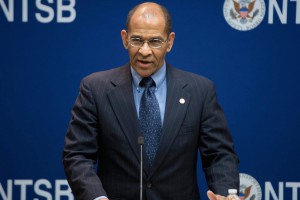
NTSB Chairman Christopher Hart called for collision avoidance technology to be standard equipment on all new vehicles.
Federal officials are recommending – again – that collision avoidance systems be made standard equipment on all new vehicles: free of charge.
“You don’t pay extra for your seat belt, and you shouldn’t have to pay extra for technology that can help prevent a collision altogether,” said Christopher Hart, chairman, National Transportation Safety Board (NTSB).
The agency released a 60-page report outlining the need for the technology, suggesting that more than 80% of the 1,700 deaths and 500,000 injuries in the 1.7 million rear-end collisions in 2012 could have been eliminated or lessened if the technology were mandated.
Currently, the technology is typically available on high-priced vehicles as part of a larger suite of technologies, such as adaptive cruise control. Including the option on a vehicle generally adds at least $1,000 to the price of the vehicle. Aftermarket versions can be purchased for as little as $1,100.
The NTSB reported that only four passenger vehicles – out of 684 models – included the technology as standard equipment last model year. It’s not the first time the agency has pushed for this mandate: it said the same thing three years ago in a similar report. The agency’s sister organization, the National Highway Traffic Safety Administration, agrees … at least about the effectiveness of the technology.
(Barra says merger with FCA not necessary. For more, Click Here.)
A recent NHTSA modeling study indicated collision warning systems would be effective in 42% of rear-end crash situations where the lead vehicle was decelerating, and effective in 75% of rear-end crashes where the lead vehicle was not moving. Overall, collision-warning systems would be 51% effective.
The NTSB has made 12 recommendations over 20 years in favor of forward collision avoidance technologies, including 10 recommendations resulting from an earlier Special Investigation Report in 2001.
(Click Here for details about Panasonic helping Tesla launch the gigafactory.)
The progress on these recommendations, however, has been very limited. The report notes that a lack of incentives and limited public awareness has stunted the wide adoption of collision avoidance technology. Hart doesn’t want to hear about costs or waiting for a better iteration of the technology.
“The promise of a next generation of safety improvements has been used too often to justify inaction,” Hart said. “Because there will always be better technologies over the horizon, we must be careful to avoid letting perfection become the enemy of the good.”
(To see more about states cracking down on left lane hogs, Click Here.)
The NTSB recommends that NHTSA develop tests and standards in order to rate the performance of each vehicle’s collision avoidance systems and to incorporate those results into an expanded NCAP five-star safety rating scale.

Anyone who believes that consumers don’t pay extra for seat belts, 5 mph impact bumpers, airbags, 54.5 mpg CAFE standard, etc. is clueless about the sticker price on a car.
‘Free of charge’… Right. Just something else to jack the price of cars up. Between this and the new CAFE standards, you’ll be lucky to be able to buy a Ford Focus for under $50,000.
One of the big challenges, Chuck. All the data are suggesting that recent safety additions, notably stability control, are reducing crashes and saving lots of lives. The early data suggest collision avoidance is further improving things. But will Americans be able to afford this technology? The reality is that it is now taking a near 6-figure income to be able to afford even lower-end new cars.
Paul A. Eisenstein
Publisher, TheDetroitBureau.com
No disrespect Paul but as we have seen over and over again, those with an agenda report the statistics as they want them to be believe. I do believe that some of the tech does reduce accidents and injuries but at what cost to consumers is always the question. Sticker prices will continue to escalate with mandated tech and thus discriminate against even middle income consumers.
“You don’t pay extra for your seat belt…” In what dream world does he live?
It illustrates firsthand how removed from reality the POTUS, EPA and NTSB bureaucrats are with reality. They need to justify their excessive compensation so they dream up some pretty irrational ideas that always cost consumers and typically have marginal value such as gasohol and mandated alcohol content in gasoline, which damages many engines.
“In what dream world does he live?”
In the dream world where lunches are free!
…and paid for by tax payers!